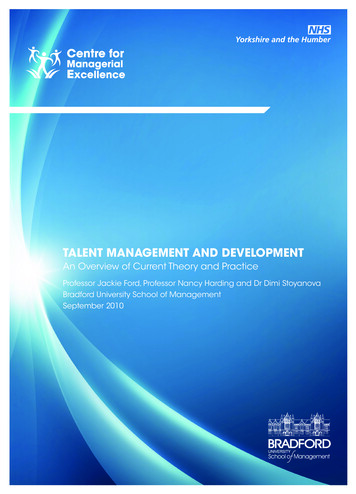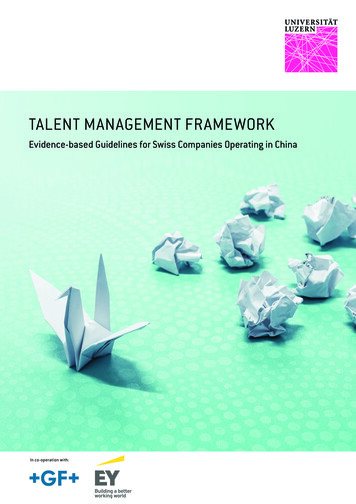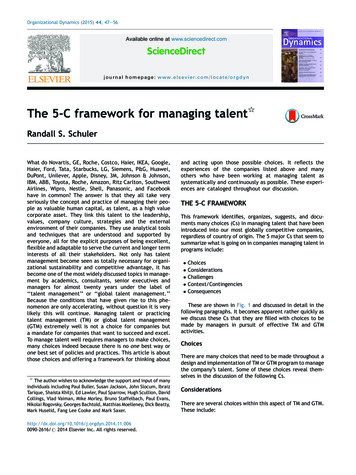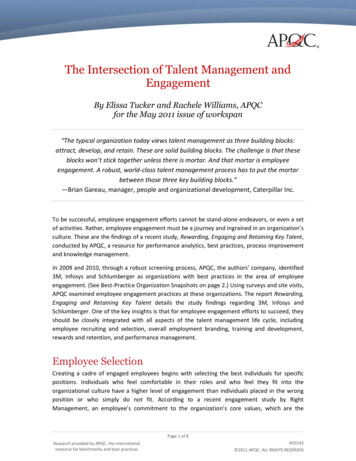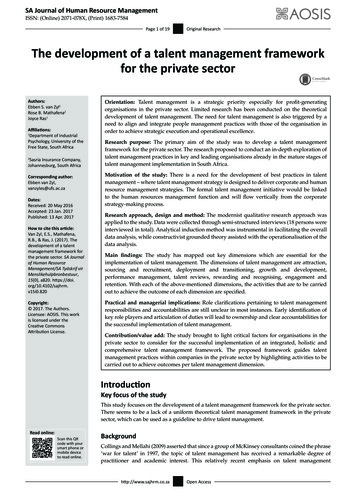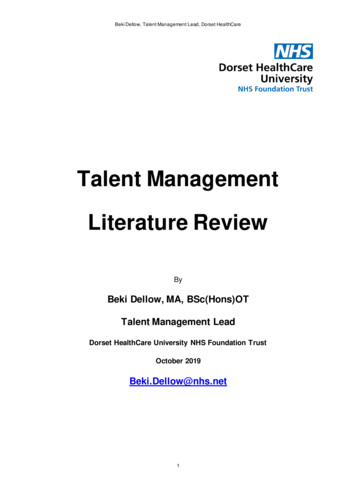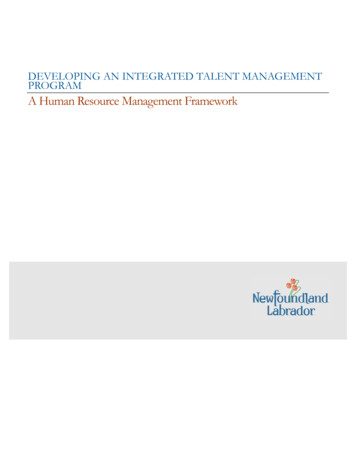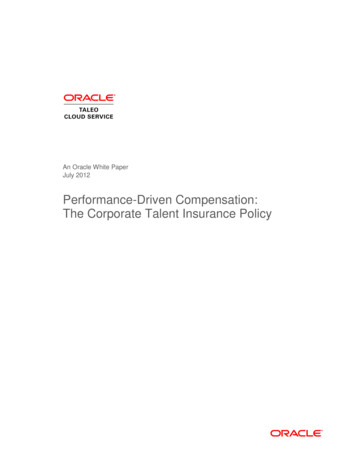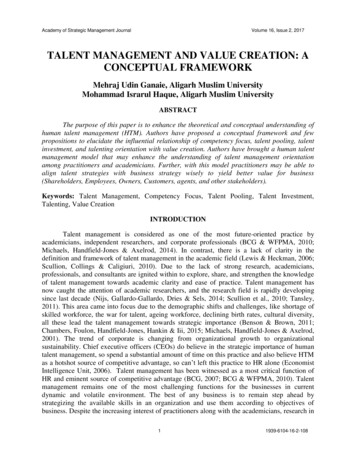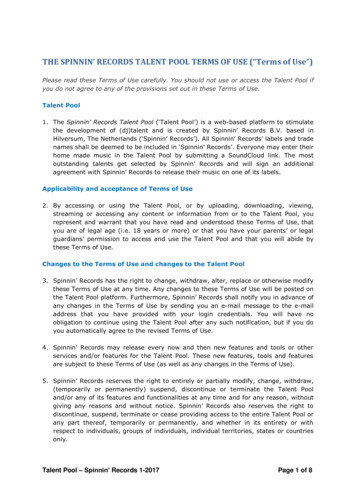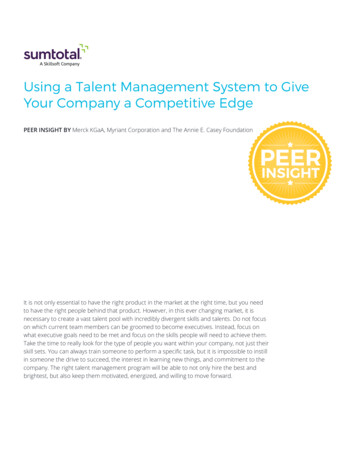
Transcription
Using a Talent Management System to GiveYour Company a Competitive EdgePEER INSIGHT BY Merck KGaA, Myriant Corporation and The Annie E. Casey FoundationPEERINSIGHTIt is not only essential to have the right product in the market at the right time, but you needto have the right people behind that product. However, in this ever changing market, it isnecessary to create a vast talent pool with incredibly divergent skills and talents. Do not focuson which current team members can be groomed to become executives. Instead, focus onwhat executive goals need to be met and focus on the skills people will need to achieve them.Take the time to really look for the type of people you want within your company, not just theirskill sets. You can always train someone to perform a specific task, but it is impossible to instillin someone the drive to succeed, the interest in learning new things, and commitment to thecompany. The right talent management program will be able to not only hire the best andbrightest, but also keep them motivated, energized, and willing to move forward.
www.skillsoft.comExecBlueprints in partnership with Aspatore BooksAction PointsI. The Right StuffThe vice presidents from Merck KGaA, Darmstadt, Germany,Myriant Corporation, and The Annie E. Casey Foundation discuss:Using a TalentManagement Systemto Give Your Companya Competitive EdgeFinding the right people for the job is no longeras simple as placing an ad in the newspaper.Nowadays, you need complex algorithms and along list of adjectives to even begin the search.Take the time to determine exactly who you want,what you want them to do both now and in thefuture, and how their specific skills can help yourcompany succeed.II. The Bottom LineCompany culture is essential to success.Developing future leaders, educating employees,and allowing the best and brightest to shinewill increase company value in a way that mereproducts cannot.III. Must-Have Character TraitsPeople who claim they are detail-oriented, driven,and good collaborators are a dime a dozen. Don’tlook for specific skills, but rather overall charactertraits that are broader and show more diversity inthought and action.IV. The Golden Rules For MeasuringSuccessOnboarding, long-term orientation, andperformance evaluations are a great way toascertain whether your employees have beensuccessfully integrated into the company. Makesure the process is inclusive and informative sothat you can understand what core competenciesmay still need to be acquired.V. Essential Take-AwaysOnce someone is hired, don’t neglect their overallgrowth. Use their skills, knowledge, and desire tosucceed to your company’s benefit. Offer themas many opportunities to expand the breadth anddepth of their knowledge as you can.ContentsAbout the Authors. . . . . . . . . . . . . . . . . . . . . . p.2Dr. Piotr Bednarczuk. . . . . . . . . . . . . . . . . . . . p.3Regina DeTore Paglia. . . . . . . . . . . . . . . . . . . p.7Donna Stark . . . . . . . . . . . . . . . . . . . . . . . . . p.12Ideas to Build Upon & Action Points. . . p.16Dr. Piotr BednarczukExecutive Vice President, Corporate HR and HR DeliveryMerck KGaA, Darmstadt, GermanyRegina DeTore PagliaSenior Vice President, Human Resources, Myriant CorporationDonna StarkVice President, Talent and Leadership DevelopmentThe Annie E. Casey FoundationIt is not only essential to have the right product in the market atthe right time, but you need to have the right people behind thatproduct. However, in this ever changing market, it is necessary tocreate a vast talent pool with incredibly divergent skills and talents.Do not focus on which current team members can be groomed tobecome executives. Instead, focus on what executive goals need to bemet and focus on the skills people will need to achieve them. Takethe time to really look for the type of people you want within yourcompany, not just their skill sets. You can always train someoneto perform a specific task, but it is impossible to instill in someone thedrive to succeed, the interest in learning new things, andcommitment to the company. The right talent management program will be able to not only hire the best and brightest, but alsokeep them motivated, energized, and willing to move forward. nCopyright 2015 Skillsoft Ireland Limited. All rights reserved. Reproduction in whole or part is prohibited without the prior written permission of the publisher. This ExecBlueprints document was published as part of a subscription based service.ExecBlueprints provides concise, easy to absorb, practical information to help organizations address pressing strategic issues. For more information about ExecBlueprints, please visit www.skillsoft.com.
About the AuthorsDr. Piotr BednarczukAExecutive Vice President, Corporate HR and HR Delivery, Merck KGaA, Darmstadt, Germanygraduate of the University ofCologne, Germany, with aPh.D. in Marketing and MarketResearch, Organizational Structure andDevelopment, Piotr Bednarczuk hasamassed much global experience in project management and human resourcesand HR consulting. He began his careerwith Lufthansa and has worked forHewitt Associates in the United States,Germany, and China.Dr. Bednarczuk joined Merck KGaA,Darmstadt, Germany in 2011 as theHead of Corporate Human Resources. InJanuary 2015 he also took over responsibility for HR Delivery. A U.S. citizen, heis married and has one daughter. In hisspare time, his interests include tennis,skiing, fishing, and traveling. Read Piotr’s insights on Page 3Regina DeTore PagliaRSenior Vice President, Human Resources, Myriant Corporationegina DeTore Paglia joinedMyriantCorporationinSeptember 2010 with more than20 years extensive experience as an HRexecutive creating and integratinghumancapitalpracticesandprograms to provide business supportfor talent management. Her human capitalexperience has been gained in start-up,growth, and mature organizations, including biotech, pharmaceutical, managedcare, biofuels, and specialty chemicals.From 2008 through 2010, Ms. DeTorePaglia served as Vice President of HumanResources for Mascoma Corporation, abio-based ethanol company. For the 10years previous, Ms. DeTore Paglia heldthe position of Senior Vice Presidentof Human Resources for SepracorPharmaceuticals, Inc. Ms. DeTore Pagliawas responsible for development andexecution of Human Resource strategiesto sustain the scale-up of the companyfrom 100 to over 3,000 employees,including two acquisitions. Prior to this,Ms. DeTore Paglia served as HumanResource Director, News CorporationInternet Ventures; Corporate Directorof Human Resources for Tufts HealthPlans, Inc.; and Human ResourcesManager, Fidelity Investments.Ms. DeTore Paglia holds a Bachelorof Science Degree in Business fromBoston, MA-based Suffolk Universityand a Master of Arts Degree inHuman Resource Management fromFraminghamStateUniversityin Framingham, Massachusetts. Read Regina’s insights on Page 7Donna StarkBVice President, Talent and Leadership Development, The Annie E. Casey Foundationefore joining the Foundation in1994 and playing leadership rolesin many of its key initiatives,Donna Stark was a Casey grantee managing a major systems change effort inMaryland. As director of the childrenand family services reform initiativeof the Maryland Governor’s Office forChildren, Youth and Families, she ledone of the nation’s earliest and mostambitious efforts to forge collaborationamong state agencies to better servechildren and strengthen families. Skillsoft, 2015As Casey’s vice president for Talentand Leadership Development, Ms.Stark, who holds a Ph.D. in counselingand human development from OhioState University, blends skills cultivatedthroughout her social services careerwith an understanding of the needs ofCasey staff and partners. Ms. Stark hasexpanded the Foundation’s leadershipportfolio from its signature Children andFamily Fellowship, which helps seniorand mid-career professionals hone theirleadership skills, to an array of programsthat help staff, grantees, and communities tackle some of the most challenging obstacles to success for vulnerablefamilies. Read Donna’s insights on Page 12About the Authors ExecBlueprints 2
Dr. Piotr BednarczukExecutive Vice President, Corporate HR and HR Delivery, Merck KGaA, Darmstadt, GermanyIntroduction to TalentManagementThe topic I will discuss is how talent management can assist and provide a competitive advantage forthe company. I would like to beginfirst with a little bit about what isgoing on in the business environment and why talent managementis so important. If we think aboutit in the context of the volatility inthe markets now, talent management requires that companies havethe right portfolio of products, services, i.e., the right portfolio ofassets to make sure that you canreact to the speed of change in themarkets. This is what is happeningin companies and also in the talentmanagement processes.Talent management systemsand the thinking around talentmanagement itself have been onedimensional in the past. If I havea position in the future, and thisposition is described now, and in10 years this position will be ready,then I can develop people throughtalent management to get to thatposition. The problem with the volatility of markets at the moment isthat this is not the case; the positions change, so I cannot reallydevelop people in only one dimension. I need to have a portfolio ofdifferent capabilities to ensure thatwhen I have placements and whenI need to ask for this talent, I havethe right combination of peopleto succeed for the strategy thatthe company has. This requires amuch stronger talent managementsystem within the company, first,because of the volatility of changesbased on job positions, and alsoto be frank, the fluctuation of talent coming in and coming out oforganizations.Working in today’s climaterequires quite a different set of talent management capabilities andtherefore we strongly believe thatone of the core — I would say nothuman resources (HR) processes,but core business processes —should be the talent managementprocess. To achieve the outcomewe want in the upcoming years, theimportance of talent managementwill grow beyond what it alreadyhas. In addition, there are somekey success factors companies canconsider.What we as a company focusedon was to make sure that the talent management processes reallyalign with what the company actually needs. The major discussion isthat talent management needs (orwhich talent management risks)are derived from strategic prioritiesfor the companies, independent ofthe company strategy the companies will need to decide on the following three success factors. Talentmanagement processes need to beintegrated into one process whichis followed during the entire yearWe feel that talent management contributes to thecompetitive advantage of companies, especiallycompanies that depend on the innovation of theirworkforce to sustain their advantage.Dr. Piotr BednarczukExecutive Vice President, Corporate HR and HR DeliveryMerck KGaA, Darmstadt, Germany Skillsoft, 2015Dr. Piotr BednarczukExecutive Vice President,Corporate HR and HR DeliveryMerck KGaA, Darmstadt, Germany“The combination of values,competencies, agility, and experienceenable a balanced approach to talentmanagement.” Began his career with Lufthansa Previously worked for HewittAssociates Joined Merck KGaA, Darmstadt,Germany in 2011 as the Head ofCorporate Human Resources Ph.D. in Marketing and MarketResearch, Organizational Structureand Development, University ofCologne, GermanyDr. Bednarczuk can be e-mailed atpiotr.bednarczuk@execblueprints.comand is aligned with the needs ofthe business.The Importance of GlobalConsistency within aCompanyOne factor is that we think to makea difference there needs to be globalconsistency within that process.I will give you an extreme example: if you are a multi-nationalcompany like we are, with around40,000 employees and growingDr. Piotr Bednarczuk ExecBlueprints 3
Dr. Piotr BednarczukExecutive Vice President, Corporate HR and HR Delivery, Merck KGaA, Darmstadt, Germanysubstantially, if you do not have aconsistent definition of what talentmeans, it becomes difficult to manage globally across business sectors or even within those sectors.You need this global consistency toensure that you can actually manage this in a consistent and a coherent manner. Do you as a companyhave a clear definition of “talent”that is globally lived and executed?Very often this is not the case.The Importance ofIntegrated ProcessesThe other point is that we thinkthat the talent management process cannot be an isolated process.Let’s take an extreme example froma performance process. Managersdo a performance review, that getsclosed, and then HR sends out ane-mail months after the fact and is Skillsoft, 2015now conducting the talent management process, saying please give mea list of your talents and then wewill discuss it. Basically you haveindependent processes that are notlinked to each other.We believe that in order to makea difference, the processes of performance talent, talent calibration,and succession management needto flow like one business process.You would basically have a budgeting process — during the year, youwould spread out activities, butthey reinforce and build upon eachother. For example, if I have a discussion on performance and potential, this discussion is captured inone system and is transferred overto the next process, which couldbe a calibration or a talent discussion. Many companies that make abig impact and have a competitiveadvantage have more integrated(continued)processes than isolated systems.We are moving in that direction. Weactually now have a globally consistent integrated system for thewhole talent management process,and the integration into other processes like compensation, development, and recruiting is continuing.The Importance of TalentAnalyticsIn many cases you will see companies, and you can divide theminto different categories. Somecompanies have a more informalapproach to talent management,and basically they just set certainmilestones in the process wherethey have some formal assessmentor formal governance. Other companies have a more data-drivenapproach where they derive dataout of the process, and based onDr. Piotr Bednarczuk ExecBlueprints 4
Dr. Piotr BednarczukExecutive Vice President, Corporate HR and HR Delivery, Merck KGaA, Darmstadt, Germanythat data they provide transparencyabout what is going in the companyand basically manage the processthrough transparency and data. Weare a company that believes in thisdata-driven approach. When wemake workforce decisions, they arebased on data.Having a Portfolio ofCapabilitiesWhat do we mean by having aportfolio of capabilities? Whatoften happens when companiesmake talent decisions is that several of the appointments to certainpositions are very often based onone-dimensional criteria such asexpertise.To make a decision on futureplacements, we added additional criteria to build a portfolio Skillsoft, 2015approach. One important criteriaas an indicator for future leadership capability is learning agility.Learning agility describes how agilea person is to reflect on him or herself, reflect on the work environment, and how agile they are todevelop. There are multiple dimensions, e.g. people agility. Can youwork with people with diversebackgrounds? Are you comfortableworking in such an environment?Another dimension is change agility. Are you comfortable workingin an environment that changes?So this learning agility is one of thekey predictors for future potential,especially in the leadership area.In addition to expertise andlearning agility we provide assessments based on a company competency model. This model is directlyderived from the business strategies and reflects on the behaviors(continued)leaders need to exhibit in order toachieve the business strategy.The next element in the portfolio approach is what we callthe experience profile, meaning inwhich areas people have gainedexperience, e.g. do I have experience working in different countries, do I have experience workingwith different teams, P&L experience, or do I have more projectexperience?Overall in our company theadherence to company values isalso a precondition for any placement decision.The art of talent managementis that even though you have thedata-driven approach, you stillneed good judgment to make surethat you provide the right sourceof workforce decisions for thebusiness.Dr. Piotr Bednarczuk ExecBlueprints 5
Dr. Piotr BednarczukExecutive Vice President, Corporate HR and HR Delivery, Merck KGaA, Darmstadt, GermanyHow Company CultureDrives StrategyThe biggest factor that we see driving talent passion is the companyculture. This cannot be createdby processes or tools; it has to bemore like the DNA of the company’s leaders. Through the transparency of the key performanceindicators (KPIs) that you provideand through the discussions thatyou have, you need to buildthat DNA in the company. Wherethere is a passion to develop people, leaders are rewarded for that.It is not just like a hobby forsomebody to develop; it shouldbe embedded in the company culture and it should be the expectation of the company. Therefore, ittakes time.We had a strategic shift in 2011,and many processes were newlyaligned to the new strategic priorities of the company. When youimplement a new process, it willtake two to three cycles to reallyhave an impact on the company.You must be patient in order tosee the first outcomes, because thewhole system lives throughthe discussions within the companyand through this culture of making sure that people are aware thatthis is important for the company, Skillsoft, 2015(continued)Company culture and strategy will determinethe approach that is right for you. Within ourcompany, we think we need a more globallyconsistent approach, an integrated process, andalso a data-driven process to make a differenceand to have a competitive advantage.Dr. Piotr BednarczukExecutive Vice President, Corporate HR and HR DeliveryMerck KGaA, Darmstadt, Germanyand being transparent about howimportant this is.In a nutshell, we feel that talent management contributes tothe competitive advantage ofcompanies, especially companiesthat depend on the innovation oftheir workforce to sustain theiradvantage.Developing People for OurCompanyDeveloping people for your company is quite culture-specific aswell. Basically what we follow,which is not a rigid policy, butmore like a way of thought, is theso-called 70/20/10 rule. I think itis known that 70 percent of learning is done on the job. What weare trying to do is provide enoughopportunities for people to learnthrough different assignments sothat they can build their experience profile as I described before,or build their competencies. This isan important 70 percent. 20 percent is mostly related to somethingaround coaching, mentoring, andproviding sponsors or buddies sothere is an exchange of continuousfeedback for the talent. The lowestamount of the impact, which is10 percent, is the formal training and the aspects of preparingfor different assignments. This isthe development approach that wetake to build the cycle and to ensurethat we have the right portfolio ofpeople in the organization that canfulfill the strategic requirements ofthe company in the future. I thinkthis portfolio approach is the keysuccess factor for many companiesas we move into the twenty-firstcentury. nDr. Piotr Bednarczuk ExecBlueprints 6
Regina DeTore PagliaSenior Vice President, Human Resources, Myriant CorporationHuman Resources: TheTalent PropositionOur biotechnology company’shuman resources department utilizes what we call “The TalentProposition” when recruiting andtraining new employees. Basically,“The Talent Proposition” can bereduced to a formula:Corporate Capabilities Corporate Culture Market Value Corporate Capabilities Thewhat, which refers to whatdo we do well and whatdifferentiates us from ourcompetitors. Core knowledgeis a hallmark of our productand services. The what is the“secret sauce” that fulfillsour mission and results in asuccessful organization. Thewhat is the results achieved inthe form of our products andservices. These are developedby leveraging the CorporateCapabilities. Corporate Culture The how,which refers to our uniqueTalents, Values, Environment,and Knowledge whichsupports “what” we do i.e.,produce our products andservices. From an internalperspective that includesour Infrastructure, Systems,Culture, Processes, Leadership/Direction, Management, OfficeSpace, Pay, Communication,and Rewards. The how is allthe tangible and intangiblecomponents in the workplacewhich are distinctive to ourorganization. This includes thevarious motivational factorsand physical environmentwhich enable our Talentto create our products andservices. Market Value Refers tothe revenue/profit and stockvalue produced from thesale of our products andservices. Stakeholders mustbelieve there is value in theproduct and services and arewilling to compensate thecompany above the cost ofthe production of goods andservices.In a nutshell: Results AchievedThrough People Resources andDirection Aligned with the Mission Purpose/Mission and Value toStakeholders. This translatesto the application of our CorporateCapabilities to achieve our mission to produce a product or service through the Talent of theOrganization. Along with the CoreCompetencies, the Organizationmust have a framework whichfosters those results i.e., TheCorporate Culture. Componentsof the Corporate Culture includeIn order to successfully attract, retain, andengage these individuals your Company Culturemust provide an environment which encouragesthem to stay, perform, and produce at their bestlevel.Regina DeTore PagliaSenior Vice President, Human ResourcesMyriant Corporation Skillsoft, 2015Regina DeTore PagliaSenior Vice President, Human ResourcesMyriant CorporationMr. AUTHOR can be e-mailed atFIRST.LAST@execblueprints.com“As Human Resource Professionals,we have a significant opportunity tocontribute to the strategy and value ofour company.” Joined Myriant in September 2010 Has more than 20 years extensiveHR experience B.S., Business, Suffolk University M.A., Human Resource Management,Framingham State UniversityMs. Pagila can be e-mailed atregina.paglia@execblueprints.comthe organizational resources, environment, guiding principles, andphilosophy among other factors inplace to inspire our Talent to create value in the market for stakeholders through those goods andservices.Company Mission: Be the globalleader in biotechnology with greenmarket application to maximizeshareholder values.The deliverable of the companymission is the product or servicedeveloped to achieve the mission.In the case above the product wouldbe bio-chemicals created by theengineering of organisms to represent environmentally sound chemicals used in consumer goods andRegina DeTore Paglia ExecBlueprints 7
Regina DeTore PagliaSenior Vice President, Human Resources, Myriant Corporationadditive to or a replacement for topetroleum based products.To compete within the greenmarket, you need specific talentsand skills which create the saleable products which are designatedin the Corporate Mission. The talent refers to the people hired withthese specific skills, knowledge,and experience. In order to successfully attract, retain, and engagethese individuals your CompanyCulture must provide an environment which encourages themto stay, perform, and produce attheir best level. This includes thecorporate structure, system, processes, values, resources, and allthe elements which contribute to aCorporate Culture. When all thesecomponents are aligned the endresult is the marketable product. Skillsoft, 2015The Importance of TalentAssessment and How theProcess WorksOnce the organization’s businessstrategy is defined, it important toassess the organization’s humanresources needs. Correlating thisinformation is vital to meet thecompany’s needs, whether it isexpansion, contraction, or maintaining the current status.Other benefits include: Ability to retain “StarPerformers” Increase bench strength withinternal candidates Plan for expected leadershipopenings Determine need for externaltalent(continued) Mitigate risk of future skill andleadership gapsIn order to assess talent we: Prepare an Individual SkillAssessment using aSkill Assessment Worksheet Identify skills, competencies,strengths, and weaknesses Create a professionaldevelopment plan Complete the Skill and LevelAssessment for a group ordepartment to summarizethe skill development needs,promotions, and new jobfamilies for all in the group. Use a Performance Potentialscale to assist in completing theform.Regina DeTore Paglia ExecBlueprints 8
Regina DeTore Paglia(continued)Senior Vice President, Human Resources, Myriant CorporationThe Performance Potentialscale has five levels: StarPerformer, Strong Performer,Solid Performer, QuestionablePerformer, and Low Performer.The Individual Skill AssessmentWorksheet consists of 1) Skills ofthe individual, such as assumesaccountability, adheres to corporate compliance, and demonstratesautonomy and initiative; 2) placesfor recording “Current Rating” and“Target Rating,” and 3) a place toadd a “Development Plan to BuildSkill and Competency.” For example, you may have a very talentedScientist who delivers novel andinnovative scientific results, however the person does not presenttheir findings well. A DevelopmentPlan could include the person completing a Presentations Skill Courseand then delivering a presentationto the other members of the Team.We then add data from theIndividualSkillAssessmentWorksheet to create a Team Skilland Level Assessment Worksheetwhich lays out for each team member their current key skills; the keyskills they need to develop; a SkillDevelopment Plan; whether theyare promotable and when; and ifthe team member is a “flight risk”and on what scale — i.e., low,medium, or high.We have determined that focusing solely on the Individual TalentAssessment does not provide afull view of the Company CoreCompetencies. A Team Assessmentstep was added to the TalentAssessment process to look at theculmination and deficiencies of specific skills needed within the organization. The Team view quicklyidentifies where the department asa whole possesses the core skills,where skills need to be developed, Skillsoft, 2015what the readiness is of the department members, who is promotableand when, and who is a retention risk. This snapshot providesa quick view of what action stepsare necessary to maintain, improve,change, or hire necessary experience and skills.Professional Developmentand Promotion GuidelinesAt Myriant, our ProfessionalDevelopment Plan consists of: Timing — Included with theAnnual Performance ReviewProcess. Purpose — Discuss theemployee’s professionaldevelopment goals. Objective — Understand thegap between the employee’sdesired role and theemployee’s current skill setsand experience. Action Plan — Determine aplan to help the employeeprogress toward oneprofessional development goal. Key Outcome — Establishone or more professionaldevelopment goals for the next12 months. An example mayinclude: An employee in HRwho needs to improve theirability to track compensationdata and be able to createvarious scenarios with theinformation to analyze andmake recommendations. ThisAction Plan to Link Talentand Business StrategyRegina DeTore Paglia ExecBlueprints 9
Regina DeTore Paglia(continued)Senior Vice President, Human Resources, Myriant CorporationMyriant provides resources for professional development in several ways.First, there are a number of training and development resources, availableinternally and externally, that can help employees master specific skills,knowledge, behaviors, and attitudes. Training can range from formal orinformal sessions to specific training related to the employee’s industry,position, or assignment.Regina DeTore PagliaSenior Vice President, Human ResourcesMyriant Corporationperson’s development goalcould include taking a seriesof Excel tutorials to masterpivot tables and other complexcalculations in order tofacilitate the analysis.The company’s role in professional development is as follows: Retaining key talent andkeeping employees engaged, asthey see a better professionalfuture at Myriant. Creating a culture ofemployees who are energized,enthusiastic, and committed toachieving results. Preparing employees fornew business priorities andincreasing organizationalcapabilities.Our company’s professionaldevelopment plan results in several key employee benefits: A more satisfactory work lifedue to increased professionalskills and competencies Steering/advisory committees Special projects/assignments Research/writing assignments Professional organizations Creates a sense ofresponsibility for identifyingand creating the future theywant Case studies Establishes expectations ofwhat employees can do withinour companyA promotion may be considered when an employee has takenon more responsibility and hasadvanced to a new role with a widerscope of accountability, decisionmaking, organizational impact, anddeliverables. Additionally, the business need must exist to supportthe promotion. The president willapprove all promotions.In order to be considered for apromotion, an employee must meetall of the following criteria:We believe that it is important to partner with the employeefor input in determining the mostappropriate professional development resources. Some examples toconsider: Academic coursesA manager’s role in professionaldevelopment is as follows: One-on-one coaching Improves employeeperformance Mentoring On-the-job experience Builds a reputation as amanager who develops andinvests in their people Assessment tools — SeeHuman Resources Serves to increase skill sets andperformance results withintheir
management processes. Talent management systems and the thinking around talent management itself have been one-dimensional in the past. If I have a position in the future, and this position is described now, and in 10 years this position will be ready, then I can develop people through talent management to get to that position. The problem with .

